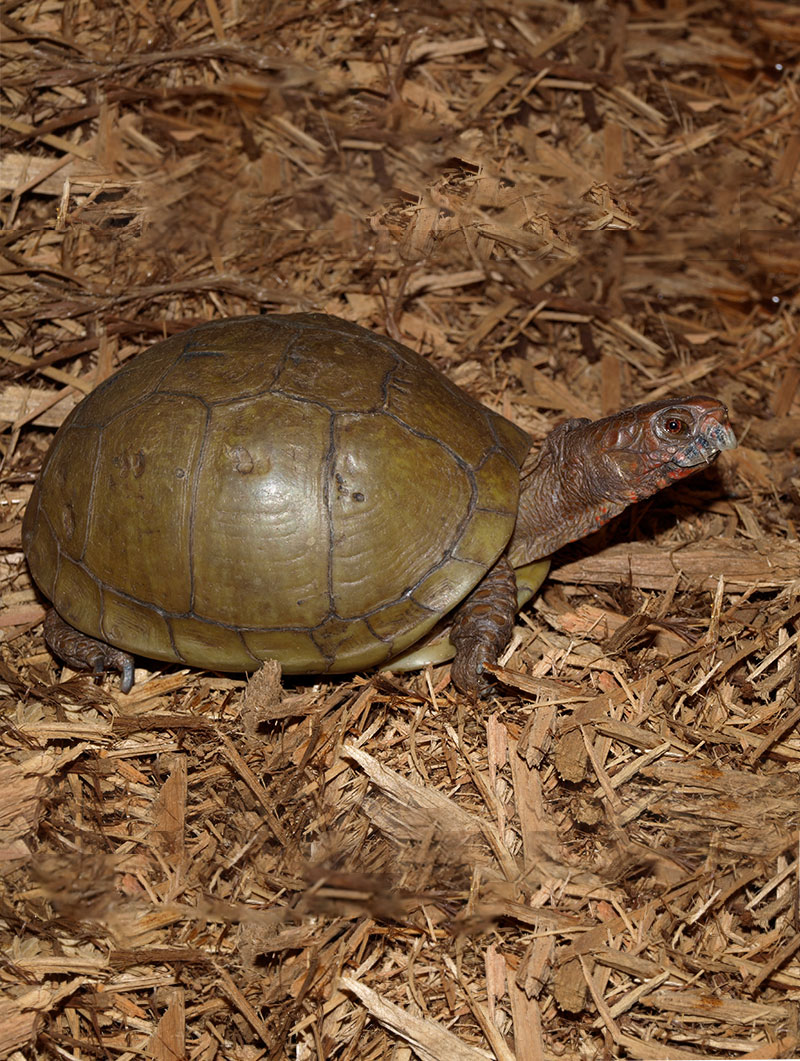Three-toed Box Turtle
Terrapene carolina triunguis
Description:
The Three-toed box turtle is a small land turtle. Its carapace (upper shell) is brown or olive in color and is sometimes patterned with yellow marks or lines. The plastron (lower shell) is the same drab color as the carapace. The turtle’s skin is brown or gray with variable amounts of red, orange, and yellow on the head and front legs. As its name suggests, the Three-toed box turtle has three toes on its hind feet. Aside from a few subtle differences, male and female box turtles look quite similar.
Size:
The average three-toed box turtle measures about 6 inches (15.2 cm) long.
Adaptations:
- To protect themselves from predators, turtles can pull their heads, legs, and tails into their shells. Box turtles have the additional ability to clamp their shells completely shut due to a hinge in the plastron. Because the shell is made of bone, very few predators can successfully consume an adult turtle.
- Box turtles have claws on the ends of their toes to assist them with digging.
- Turtles do not have teeth, but the sharp edges of their jaw (called a beak) help them to tear food into more easily digested pieces.
Diet:
At least 60% of a box turtle’s diet is composed of animal matter, including slugs, snails, worms, crayfish and insects. The rest of its diet consists of plant material such as mushrooms, moss, berries, and grasses. The box turtles at Cosley Zoo are fed a commercial turtle diet, earthworms, fruits and vegetables.
Reproduction:
Three-toed box turtles come out of their winter dormancy in March or April and mate shortly thereafter. The female turtle looks for nesting sites in June or July. The female digs with her back feet and uses her legs to press the soil up against the walls of the chamber. Digging the egg chamber is very time-consuming, taking up to eight hours. The female then lays three or four oval-shaped white eggs that are each about 1.5 inches (3.8 cm) long. The eggshells are thin and flexible. The eggs incubate for three months before hatching.
Shelter and space needs:
Three-toed box turtles are land-dwelling turtles that occasionally soak in shallow puddles of water. Suitable habitats include moist forested areas, wet meadows, pastures, and flood plains.
Life expectancy:
Some individual box turtles are estimated to be more than 100 years old. In the wild, they have high juvenile mortality rates, but those that make it to adulthood usually live 25-40 years. Box turtles raised in human care live an average of 50 years.
Relationship with man:
Box turtles help to distribute seeds by eating seed-producing berries. They also eat some insects that are considered pest species.
Fun Facts:
- In many types of turtles, including box turtles, the incubation temperature determines the sex of the hatchlings. More females are produced at higher incubation temperatures (81 degrees Fahrenheit or more) and more males are produced at lower incubation temperatures (72-81 degrees).
- Turtles do not have teeth. Instead, they have a beak that is used to tear food into pieces.
- A turtle’s shell is made up of about 60 bones. If you look closely at a turtle’s upper shell, you can see a raised line running from head to tail. This line is the turtle’s backbone.
- Like many turtles in this area, the Three-toed box turtle survives the winter by burying itself in the mud or silt at the bottom of a pond and entering a state of dormancy that is somewhat like hibernation.







